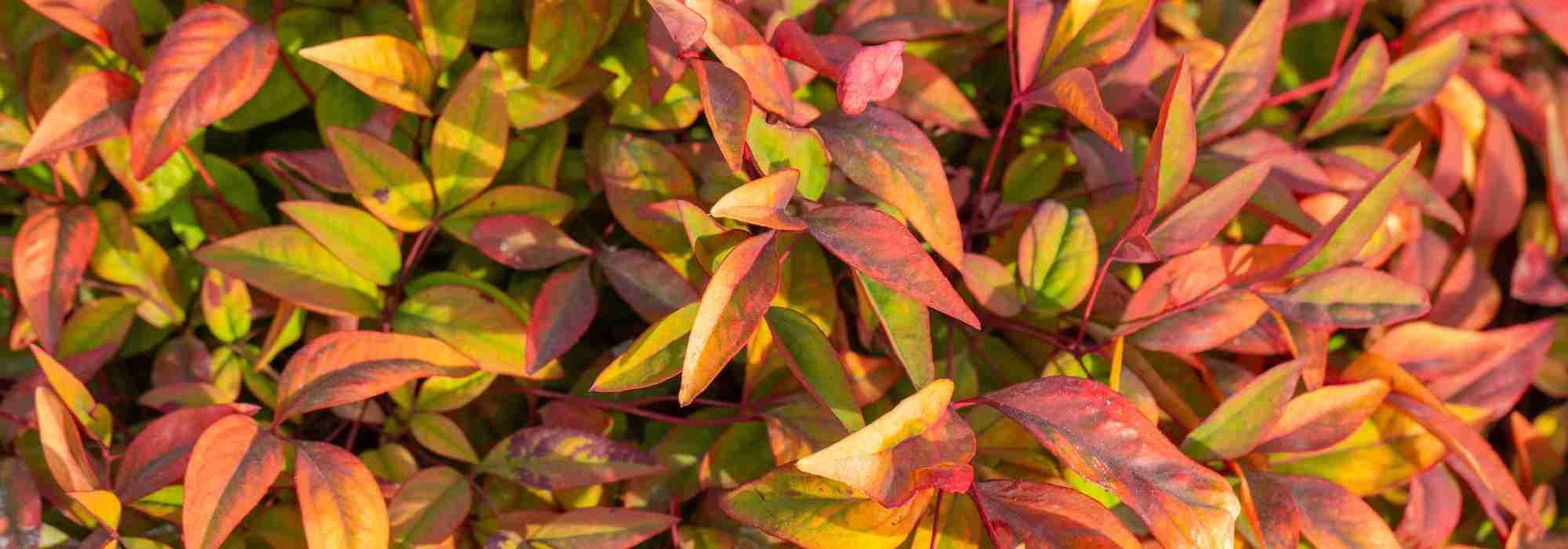
Nandina domestica: A Reliable Choice Among Decorative Foliage Plants
Colourful and easy-care bushes to brighten up the garden all year round
Contents
The sacred bamboos or Nandina domestica are bushes that can easily brighten up the garden, thanks to their decorative foliage all year round, their summer flowering and their remarkable fruiting.
Easy-going and versatile, they can fit into many spaces. They are in fact among those reliable choices that we recommend even to beginner gardeners. Let’s recap their many assets and see how to choose them well according to your needs or tastes.
The Benefits of Nandina in the Garden or in Pots
We love Nandinas primarily because they are full of ornamental qualities.
To begin with, their foliage is evergreen, meaning it remains visible all year round, even in winter when many other plants are bare. But don’t expect monotony: sacred bamboos have foliage whose colours change with the seasons, often shifting from red to green before finishing in blazing yellow, orange, or purple. Cold weather, in fact, tends to intensify the colours of Nandinas. These bushes are therefore perfect candidates for brightening up the garden and contrasting with foliage that remains consistently green.
Next, though quite subtle, the flowering is interesting. From July to September, it consists of large, loose, conical panicles, about 30 to 40 cm long. These clusters bear tiny cream-white flowers with a waxy texture and large yellow anthers. These flowers add a lovely touch of lightness and freshness. The flowering stems can be used in bouquets and Ikebana (Japanese floral art). In fact, it is a sacred plant in Asia, used to adorn temple altars.
Following this flowering, depending on the Nandina variety, bright red berries appear and persist through much of winter.
Sacred bamboos are thus interesting bushes all year round, even when the garden is dormant, sorely lacking in movement and colour.
Versatile, Nandinas can be planted anywhere: in beds, as standalone specimens, in filtered rockeries, in informal hedges, and even in pots. They bring a graphic and/or exotic touch. Also consider that sacred bamboos can easily be integrated into a privacy hedge, offering an aesthetic way to shield from prying eyes.
Beyond its decorative assets, Nandina proves easy to grow (see the following paragraph).
Finally, note that this bush is said to have astringent and sedative medicinal properties, making it a centuries-old staple in Asian pharmacopoeia.
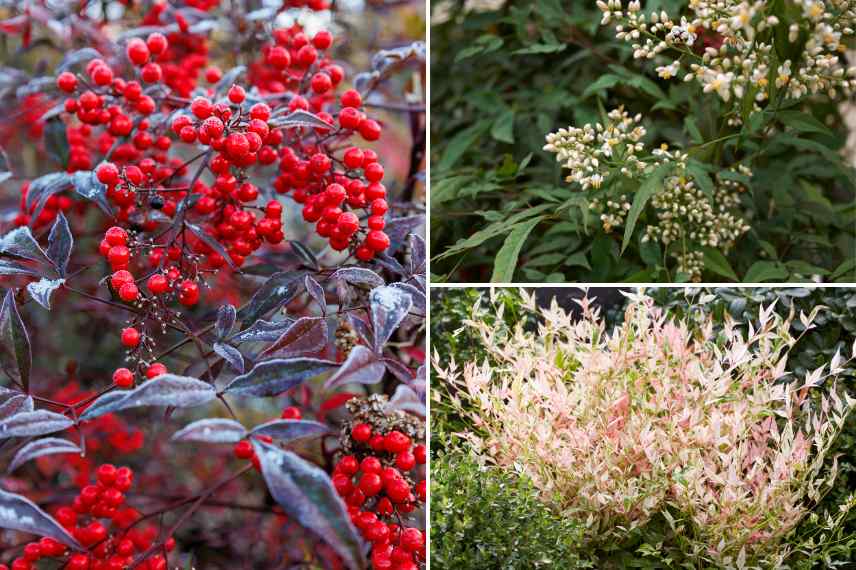
Fruiting and colours intensifying in the cold, delicate flowering, stunning new foliage: the sacred bamboo has many strings to its bow
How to grow ornamental Nandina shrubs?
Nandinas are not difficult to grow. These bushes are perfectly suited for beginner gardeners and require little maintenance.
They should be planted in partial shade or light shade. They can thrive in ordinary, even poor soil. However, richer soil with organic matter and deep cultivation will be equally appreciated. The substrate must, however, be well-drained, meaning water can flow without stagnating. Sacred bamboos prefer acidic soil and will not tolerate excess limestone. Consider adding heather soil at planting time if needed.
Once established, they can withstand summer drought, but do not appreciate extreme heat or scorching exposures. In terms of hardiness, they can tolerate frosts down to -12 to -15°C, making them adaptable to most regions. However, choose a location sheltered from cold and drying winds.
But they can also be grown in pots. This allows you to brighten up terraces, balconies, or courtyards, and enjoy their beauty even in regions with harsh winters or overly chalky soil.
Sacred bamboos have the advantage of tolerating pollution and sea spray: a boon for urban gardens or coastal gardens.
In terms of care, they will only need watering during drought, especially in the first two years after planting. In pots, however, you will need to water more regularly, as water evaporates quickly. Consider mulching around the base of Nandinas to retain moisture longer and reduce watering frequency.
In preparation for winter, renew the mulch with a thick layer (dead leaves, straw, hay, etc.) to better protect the bushes from the cold.
In late winter, simply prune the naked, weak, or damaged stems back to ground level.
Nandinas are rarely affected by parasitic pests or diseases.
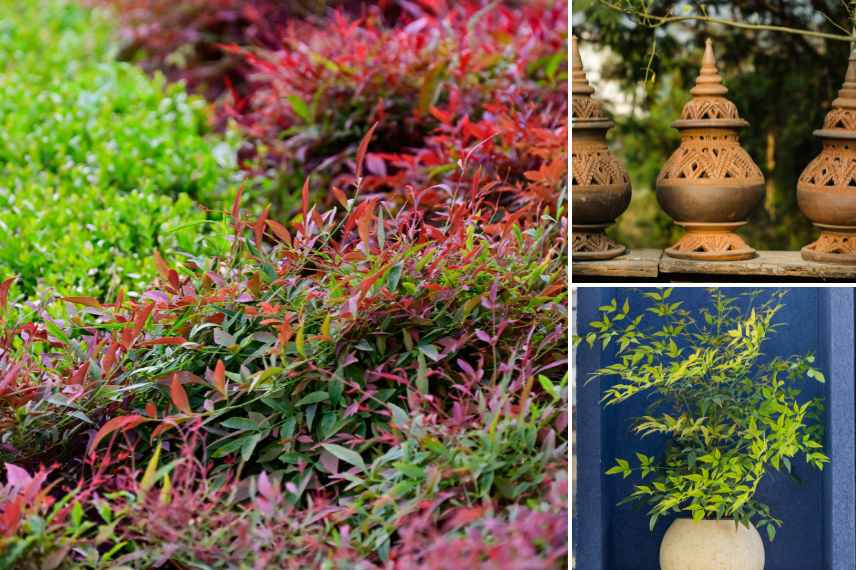
In beds or pots, place Nandina domestica ideally in partial shade for optimal flowering and fruiting
How to Choose the Right Ornamental-Leaf Nandina?
While there is only one species of sacred bamboo (Nandina domestica), there is no shortage of choice when it comes to the varieties available. Around sixty are recorded, differing in their colours or habit.
By size and use
Sacred bamboos can range from 50 cm to 2 metres in height on average. Smaller varieties are ideal for container growing, borders or low hedges. They also work well for dressing up the front of a flower bed. This is particularly true of ‘Fire Power’, a dwarf variety forming a lovely compact ball of 60 cm in all directions, with vibrant colours. Even smaller, ‘Pretty Flamingo’ does not exceed 50 cm in any direction. ‘Lemon Lime’ is another variety with a moderate habit (70 cm in all directions), distinguished by its bright chartreuse to lime-green leaf, dense and bushy. Also worth mentioning is ‘Blush Pink’ (75 cm in all directions), with vivid colours.
To dress up a dappled rockery or create attractive ground cover, consider varieties that are wider than they are tall, such as ‘Sienna Sunrise’. This bush reaches 90 cm in height with a spread of 1.20 metres. We also love its finely cut, ever-changing leaf.
For creating a hedge or as a standalone feature, opt for slightly more imposing sacred bamboos. This is the case with the standard species Nandina domestica, which grows to 2 metres tall with a spread of 1.20 metres.
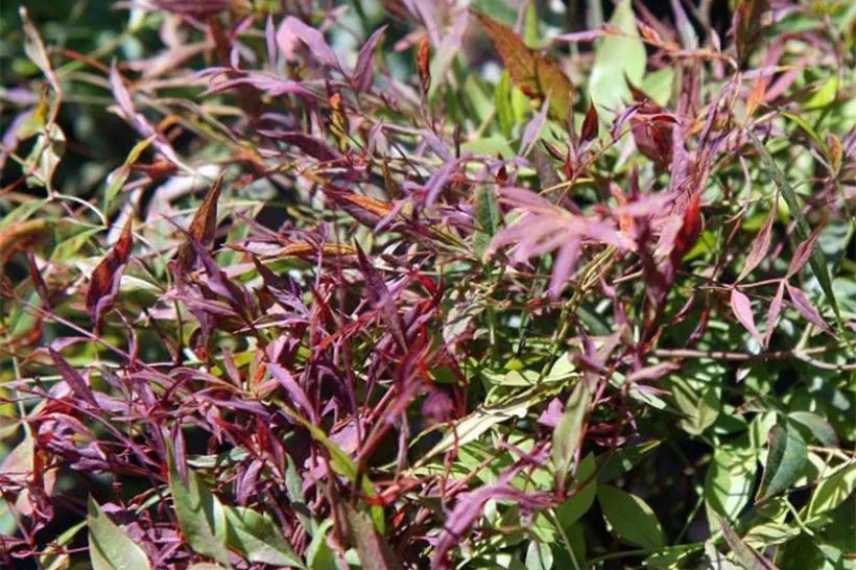
Nandina domestica ‘Sienna Sunrise’
By leaf colour
As we’ve seen, leaf colour is one of the main decorative assets of Nandinas. They often display shades of red, green and purple.
‘Lemon Lime’ prefers to play with green to golden hues, much like ‘Brightlight’, with its lemon-green leaf.
For very warm orange tones, choose ‘Gulf Stream’, which first reveals a beautiful bronze-green before turning orange-red. ‘Magical Sunrise’ delights us with brick-orange leaf in spring—a less common colour—which then evolves more conventionally into green, then golden red. A variety also notable for its rounded habit and arching silhouette.
For a very elegant purplish-red, grow ‘Flirt’ or ‘Plum Passion’.
Let’s not forget the variegated varieties, always original. This is particularly true of ‘Twilight’, which first produces coppery-pink young shoots, turning to light green leaf variegated with creamy white in summer. The small ‘Red Light’ also stands out with its delicately variegated leaf. Mature leaves display a bluish-green mottled and striate with creamy white.
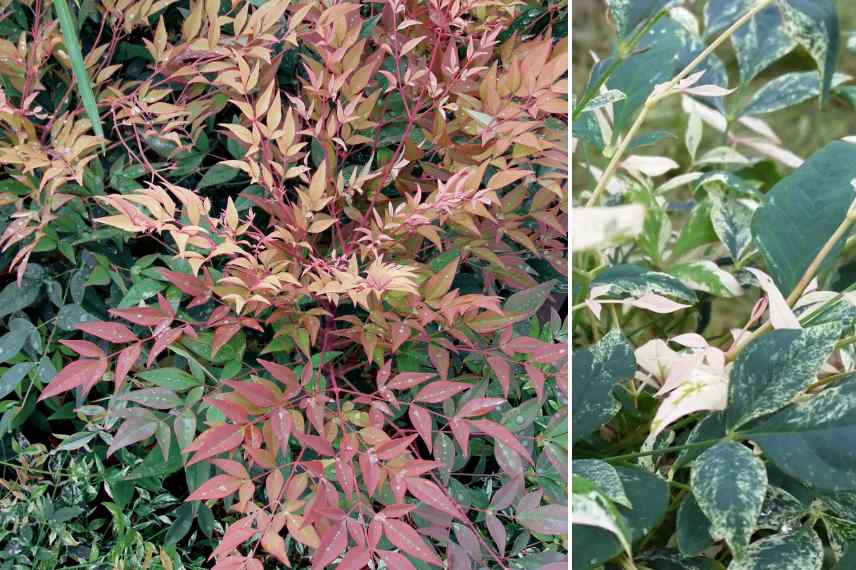
Nandina domestica ‘Gulf Stream’ and the variegated variety ‘Twilight’
By fruiting
If you want to enjoy the decorative berry of sacred bamboos to add a splash of colour in winter, choose the most generous varieties. This is particularly true of ‘Richmond’, known to be more floriferous than the standard type. This sacred bamboo produces large clusters of bright red fruit, which pair beautifully with the orange-red autumn leaf.
The cultivar ‘Obsessed Seika’ also allows us to enjoy decorative fruiting. That from the previous year often coexists with the summer flowering of the current year, creating a very striking contrast.
Note that having several sacred bamboos in the garden encourages fruiting.
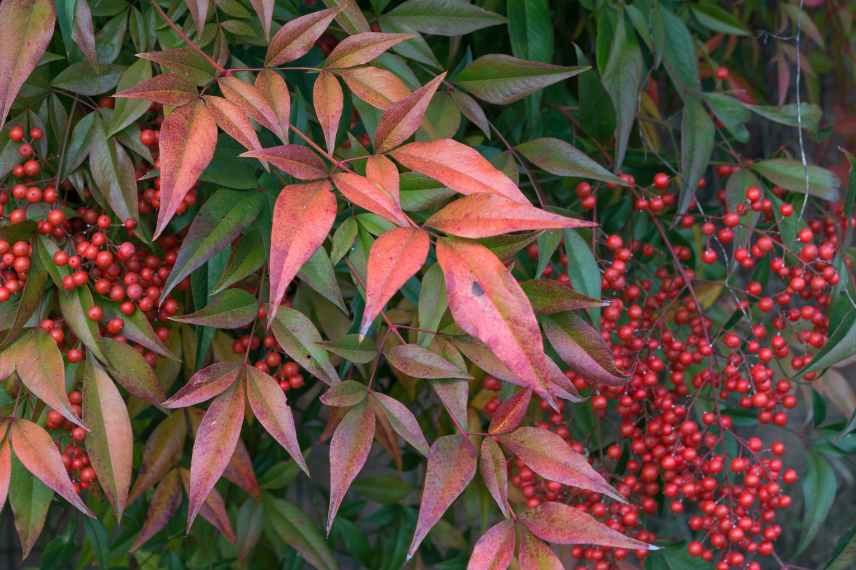
It’s also the fruit in the form of berry that delights us so much in Nandinas!
How to pair Nandina with decorative foliage?
The Nandina is not difficult to combine in the garden. It will suit contemporary scenes as well as Japanese-inspired or exotic styles.
It is entirely possible to combine several varieties of sacred bamboo to create a colourful and dynamic atmosphere throughout the seasons.
You can, for example, pair Nandina with heather soil bushes such as camellias, Rhododendrons, Pieris and Hydrangeas.
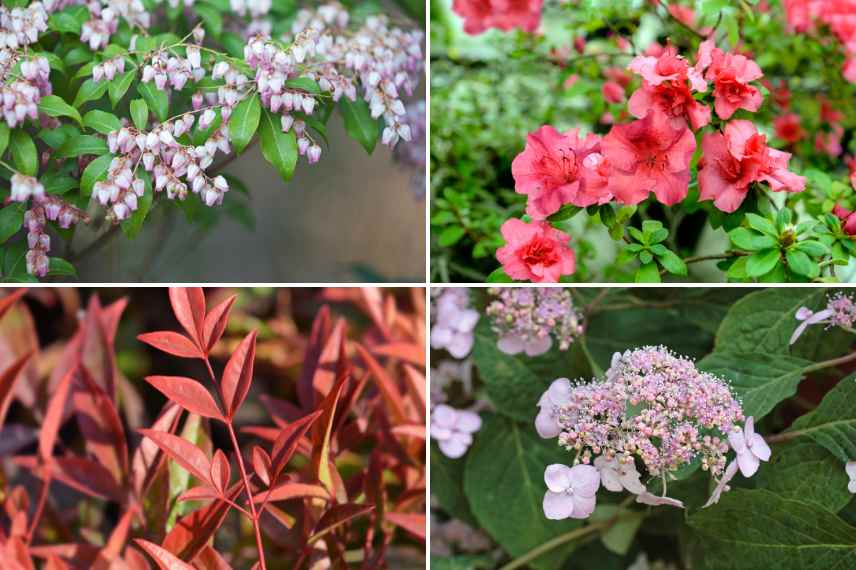
Pieris, Azalea, Hydrangea: alongside bushes with Japanese connotations, the sacred bamboo works wonders (here the ‘Gulf Stream’ variety)
In contemporary gardens, sacred bamboos will mingle with ornamental grasses such as Pennisetum or Stipas. Agapanthus will add an extra graphic and floral touch.
In flowering hedges, plant Nandina alongside Mexican orange blossom, spiraeas or Deutzia.
To play on winter fruiting that lifts the spirits, consider planting sacred bamboos near Callicarpa, Cotoneaster or Berberis.
For a beautiful autumn scene, pair them with asters, persicarias, Japanese maples, spindle trees or witch hazels.
Jean-Christophe gives you even more ideas in Nandina, sacred bamboo: 5 combination ideas.
- Subscribe!
- Contents
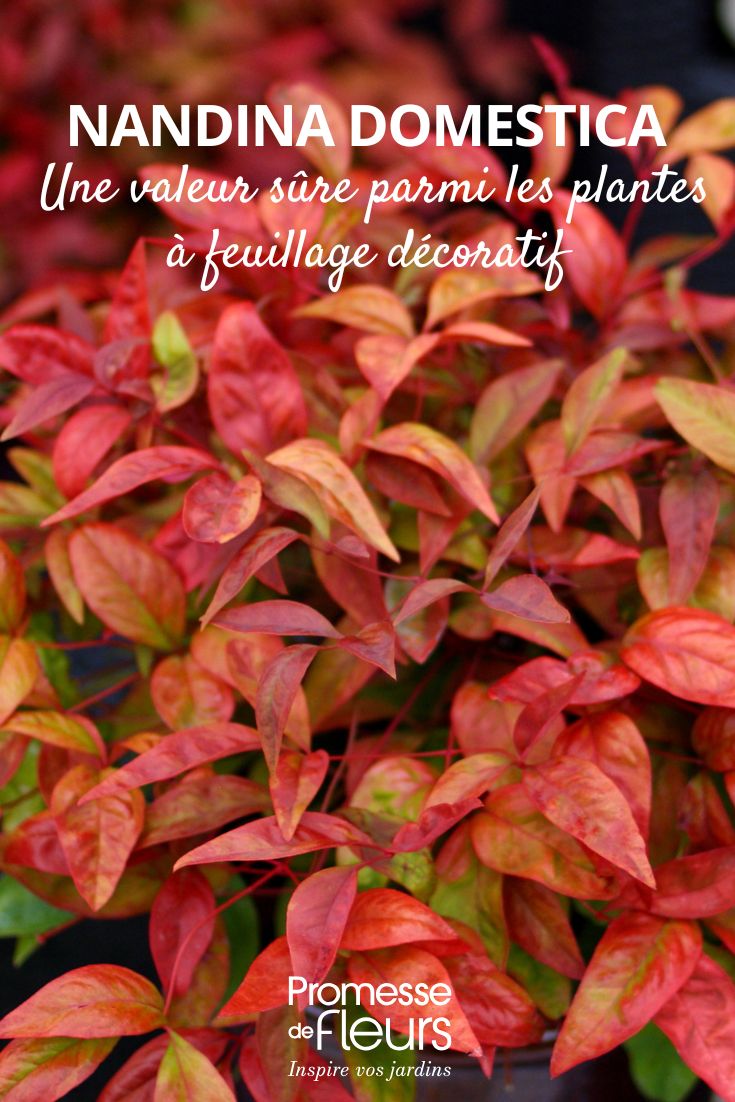































Comments